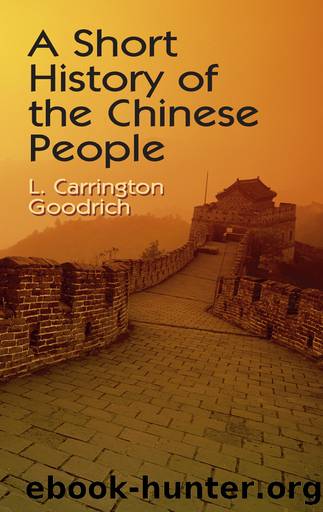A Short History of the Chinese People by L. Carrington Goodrich

Author:L. Carrington Goodrich
Language: eng
Format: epub
Publisher: Dover Publications
CHAPTER V
Disunion; the Sung and the Partition of the North and Northwest
THE FIVE DYNASTIES AND THE TEN INDEPENDENT STATES
THE collapse of the Tâang dynasty was followed by political chaos. Secessionist movements were successful in various parts of China; several adventures, three of them foreign (belonging to a Turkic tribe, called by the Chinese Sha-tâo), succeeded in exercising imperial power in part of the north from 907 to 960; and Manchuria and Mongolia in the extreme north were overrun between 907 and 1125 by the Khitan, a Mongol horde who constantly increased their territory at Chinaâs expense. A glance at an historical atlas shows the extent of the disunity. Chinese historians call these years the period of five dynasties and ten independent states and characterize them as some of the darkest in the history of the empire. âNo wonder,â says Wang I-tâung, âthat Ou-yang Hsiu [1007â1072, historian of this period] should habitually begin his âhistorical essayâ with the word âAlas!â for the picture of facts and conditions of life of this time would move anyone to pity and terror. The military governors and powerful magistrates had made themselves âprinces,â âkings,â or even âemperorsâ over great or small pieces of territory, and ruled as licentious tyrants. Organized bandits counted into the millions ran over the country, pillaging, burning, killing, sacking cities, and indulging in all forms of cruelty and extortion.â1
The life of luxury led by the wealthy despotic landholders gave rise to one form of sensual satisfaction, the binding of womenâs feet, which first appeared about 950. No one knows exactly how the practice originated, but it is believed to have begun among the dancing or ballet girls who were so popular in this age that at least a million of them were held in bondage during the Tâang period. Perhaps the style of shoe in the tenth century required excessively small feet, and the dancersâ solution of the problem was rapidly and widely adopted by other women. However this may be, the practice became so deeply imbedded in Chinese mores that it persisted some time after 1912, in spite of preaching and ridicule for more than a century and government disapproval during recent decades. It is worth noting that the practice was not adopted among certain small segments of Chinese society such as the boat women of Kuang-tung and the aboriginal peoples of the southwest, or by Chinaâs neighbors and one-time conquerors, the Jurchen, Mongols, and Manchus; but in China, rich and poor alike submitted to it.
This period is marked by one great advanceâprinting came into its own. Instead of serving merely as an occasional substitute for copying, it now became necessary for all the literate groups in the empire. That it penetrated Korea is made clear both by material evidence and by evidence from contemporary literature. It was also taken up by the Tangut of Kansu, the Khitan and Jurchen of north China, and the Uigur of central Asia. In addition to the Diamond SÅ«tra of 868, there are printed
Download
This site does not store any files on its server. We only index and link to content provided by other sites. Please contact the content providers to delete copyright contents if any and email us, we'll remove relevant links or contents immediately.
| Central Asia | Southeast Asia |
| China | Hong Kong |
| India | Japan |
| Korea | Pakistan |
| Philippines | Russia |
The Rape of Nanking by Iris Chang(3508)
The Sympathizer by Viet Thanh Nguyen(3467)
World without end by Ken Follett(3004)
Ants Among Elephants by Sujatha Gidla(2920)
Blood and Sand by Alex Von Tunzelmann(2606)
Japanese Design by Patricia J. Graham(2552)
City of Djinns: a year in Delhi by William Dalrymple(2131)
Inglorious Empire by Shashi Tharoor(2098)
Foreign Devils on the Silk Road: The Search for the Lost Treasures of Central Asia by Peter Hopkirk(2053)
In Order to Live: A North Korean Girl's Journey to Freedom by Yeonmi Park(2050)
Tokyo by Rob Goss(2014)
India's Ancient Past by R.S. Sharma(1982)
India's biggest cover-up by Dhar Anuj(1979)
The Great Game: On Secret Service in High Asia by Peter Hopkirk(1959)
Tokyo Geek's Guide: Manga, Anime, Gaming, Cosplay, Toys, Idols & More - The Ultimate Guide to Japan's Otaku Culture by Simone Gianni(1941)
Goodbye Madame Butterfly(1930)
The Queen of Nothing by Holly Black(1748)
Living Silence in Burma by Christina Fink(1726)
Batik by Rudolf Smend(1718)
